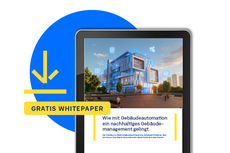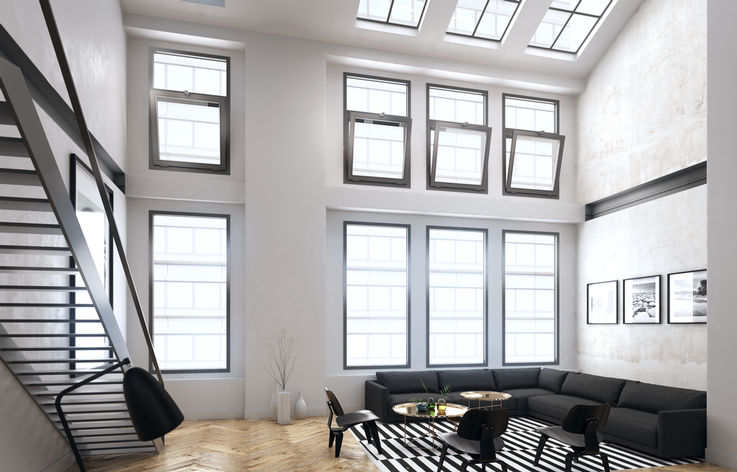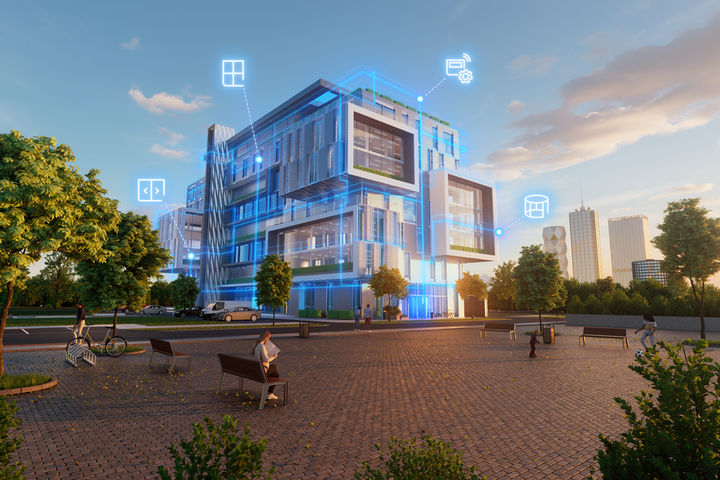Building automation - intelligently networking building operation
All commercial buildings are now built with automatic building controls. Heating, light, air conditioning, cooling, shade control and door and window technology are networked,and communicate with each other. The components can be controlled conveniently, centrally and with little contact using intelligent building management systems.
Objectives: energy efficiency, comfort and safety
It is not only cars that will drive themselves in the future: buildings are also becoming increasingly automated. They automatically regulate heating, ventilation and air conditioning themselves. They switch lighting to right level depending on the external brightness and whether there are people present in the room. They raise or lower blinds, and open and close windows and doors. And they do all this while responding precisely to users’ or residents’ needs as they pass through the building. When they leave the building, energy consumption is automatically reduced to a minimum, accesses are locked and the alarm system is activated.
This type of automation technology is now installed in all new public buildings and commercial properties. Older, existing properties are also optimised. The key phrase is definitely building automation. Automation means any action not performed by a human that affects a device or system. Building automation (BA) refers to the sum of equipment used for automatic control, regulation, monitoring and optimisation in buildings.
This means that all the sensors, actuators, operating elements, consumers and other technical units in the building are networked. Building automation then automatically performs specific functional processes as part of the building technology, in accordance with the prescribed settings. Technical building equipment, which can often be complex, is therefore efficiently and centrally managed. The goal is to make building operations more energy-efficient, economical and safer, and to offer maximum comfort to users and residents.
Structure of the building automation in accordance with DIN EN ISO 16484
The management level monitors the system and optimises its operation using special software - a building management system. The software visualises and saves information and data.
The automation level handles the collation and evaluation of information. Switch and positioning commands are sent back to field level. However., they can also be transferred to all of the other levels in the command level.
The field level involves the execution of all functions and measurement and reporting of data. This data comes from sensors (for example temperature sensors, air quality sensors, luminosity sensors, movement detectors, window contacts, wind speed sensors, rainfall sensors) and actuators (servo motors for valves and flaps, switch and dimming equipment for the lighting, drives for sun shades, windows and doors) and other push buttons and switches.
To transfer information from the sensors or positioning commands to actuators, the devices need to be linked in a shared network.

Download white paper
You can learn more about building automation and its influence on sustainability in our white paper.
Download white paper on building automation now
EU Regulation on the overall energy efficiency of buildings
The EU regulation on the overall energy efficiency of buildings is the driver behind building automation. After all, 40 per cent of total energy consumption within the EU is within the building sector. According to the EU regulation, the overall energy performance of all buildings needs to be improved. This is primarily dependent on the thermal envelope and the nature of the technical building equipment. The facilities can also be further improved by installation of an automation system.
A study at the Biberach University of Applied Sciences ('Ensuring energy efficiency via building automation with respect to DIN V 18599 and DIN EN 15232') examined how much energy the individual functions in a building automation system can save. Among the study results, it was found that automated lighting in combination with a light-directing external blind produced a savings potential of around 40 per cent. If investment costs and savings are compared, the result is an average amortisation time of two to ten years for building automation systems.
In summary, the study identified that building automation could make a big contribution to the energy efficiency of a building. It has therefore been scientifically confirmed that normal user behaviour often leads to unnecessarily high energy consumption.
Automation as an 'ideal' user
'Ideal' users would need to turn the heating off when they ventilate rooms, and then close windows as quickly as possibly again. Additionally, they would turn lights on only if the room is being used, and then use only the number of lights needed. In unused rooms, and usually at night or on public holidays, they would noticeably decrease the air temperature in offices.
Since these types of ideal users are very rare – indeed non-ideal users forget about open windows and leave them open overnight - this gap can be significantly closed with the help of building automation. Smart Buildings therefore behave in a more energy-efficient way than people.
Automated ventilation for better indoor air and greater hygiene
Building automation can improve not only energy efficiency, but indoor air quality too. This is because smart window systems that are networked with the building management system enable automated, natural ventilation. This allows rooms to be ventilated as needed and supplied with fresh air – completely contactlessly thanks to smart window automation. This avoids physical contact and thus the possibility of transmitting germs and viruses. A further advantage: regular air exchange improves indoor air quality – this is good for concentration and reduces the concentration of aerosols, thus also reducing the risk of infection from viruses.
Smart Building and Smart Home

Smart Building technologies are a growing market. © Exorbitart / GEZE GmbH
Smart Building Systems are not only used in office and industry buildings, hotels or hospitals, however. There is also growing interest in automation technology for homes. ‘Smart Homes’ are those where the power supply and consumption controls are networked with household devices and lighting.
Home networks with entertainment electronics, monitoring and safety systems, blinds, window and door closer systems can also be connected. These functions can be adapted to the individual needs of users and therefore ensure increased comfort. They also help to save costs and to save on resources.
What is BACnet?

BACnet stands for Building Automation and Control networks. It was developed in 1995 under the auspices of the American Society of Heating, Refrigerating and Air-Conditioning Engineers (ASHRAE) as a higher-order protocol in building automation. BACnet has been documented in ISO 16484 Part 5 since 2003.
What is so special about BACnet?
The goal of BACnet is to create a manufacturer-independent communication protocol for intelligent components and systems in building automation applications. This means that BACnet allows automation components from different manufacturers to exchange information with each other without incurring license fees for special data transfer hardware.
How is BACnet used?
BACnet is used when many different actuators and components from different manufacturers are to be linked in a network via one protocol.
The prerequisite for interoperability between devices from different manufacturers are the BIBBs defined in ISO standard 16484-5. BIBB stands for BACnet Interoperability Building Block and defines the needs that must be met to use the BACnet protocol.
Good to know: All supported BIBBs, object types, character sets and communication options are stated in the PICS (Protocol Implementation Conformance Statement) documents for each device.

More efficiency, lower costs - thanks to smart building automation
In our brochure, you can find out how intelligent building automation solutions from GEZE can sustainably reduce your operating costs. At the same time, you increase comfort and safety in your building - and it pays off faster than you think!
Start into the future of building automation now!
The next generation of networking

© GEZE GmbH

GEZE window and door drives can be integrated into a building automation system via open interfaces © GEZE GmbH
With myGEZE Control, we bridge the gap in building automation with a smart solution for networking door, window and safety systems. The myGEZE Control connectivity platform with modular software and open interfaces heralds completely new approaches to building automation for planners and operators everywhere.
- For greater efficiency, safety and comfort
- For dynamic safety and fire protection concepts, intelligent smoke and heat extraction and the targeted release of escape routes
- For more networking options
The central device is a standard control unit (PLC). The hardware components consist of an embedded PC control system that has a certified BACnet communication interface. myGEZE Control can be integrated into building management system, danger management and CAFM systems from any manufacturer.
In addition, stand-alone visualisation solutions for GEZE product systems are made possible by the myGEZE Visu software option. The advantages of the new platform: Automated processes and central monitoring make the system easier, more comfortable and safer to use – while also enabling energy-efficient operation of the entire building. So you have complete control!
Your investment in myGEZE connectivity pays off

© GEZE GmbH
With our myGEZE connectivity amortisation calculator, we can determine how quickly your investment in intelligent building automation will pay off - through cost savings, improved safety and better air quality.
Calculate the amortisation period for your buildingmyGEZE Connectivity at a glance
– Efficient and safe building automation system for GEZE products
– Up to 200 GEZE products can be connected, depending on the hardware configuration
– Secure data exchange via the BACnet and KNX communication standard
– BTL certified in accordance with BACnet standard ISO 164845
– High-performance hardware for installation in control cabinets (top hat rail mounting)
– BACnet device profile BACnet Building Controller B-BC
– Extension with the myGEZE Visu visualisation system to control individual scenarios, monitor door and window systems and operate them in a user-friendly way.
– Utilisation of data from the entire GEZE product portfolio
– EES and heat extraction systems: quick and flexible remote intervention possible in the event of alarm messages
– Can be used by any operator thanks to the open standard
– Higher system availability thanks to centralised monitoring
– Flexible and scalable solution that can be expanded cost-effectively if required
Smart planning
myGEZE Control simplifies the integration of door, window and safety technology for you as planners and specialists in technical building equipment. More building automation functions can be included. GEZE standardised networking components and customised project support ensure planning reliability. myGEZE Control is an attractive solution for manufacturers of building management systems and system integrators.
Benefits of myGEZE Control
- Planning certainty
- Expansion of the portfolio
- Extended functionality
GEZE provides support when determining individual needs in line with your applications.
Smooth and interdisciplinary action
The BACnet open communication protocol enables smooth and interdisciplinary operations. The myGEZE Control networking solution integrates the areas of door, window and safety technology into all areas of a building management system. Because of this, automated processes in the building and central monitoring make using the property more convenient and safer.
Benefits of myGEZE Control
- Efficiency in the building phase
- Rapid response in the event of failure
- Flexibility in the event of changes to plans
GEZE supports you in your planning, installation and commissioning
Planning:
- Project planning for your myGEZE Control solution
- Preparation of all necessary documents (cable and wiring plans, EDE files, etc.)
- Configuration of necessary components
Installation:
- Connection of components and hardware
- Product networking
- Connection to the building management system
Commissioning:
- myGEZE Control configuration
- Customisation of your operating interface
- Ensuring proper operation
Smart operation
myGEZE Control unit enables the operators of a building to make significant financial savings while at the same time improving the safety of the building and the people inside it. We create standardised BACnet project developments that can be used independent of the service provider or building management product used. This makes it possible to implement them in building management, danger management and CAFM systems from any manufacturer. GEZE supports you through all phases of the building life cycle, starting with early planning to comprehensive project management and commissioning, as well as maintenance and support in building operations.
Benefits of myGEZE Control
- Comfort
- Safety
- Efficiency in building operation
Benefits for the operator:
- monitoring provides ongoing transparency in building operations
- derive valuable information from the data generated to promote efficient building operation
- emergency exit system monitoring tracks the status at all times, increasing safety through immediate intervention
- location-independent operation of automatic doors provides additional comfort and increases efficiency
GEZE also takes over:
- maintenance and updates of hardware and software components from a single source
- ongoing optimisation in building operation



